
| Home
Mission 2007 Team Members Research Sources Progress Journal |
e-mail: adinafb@mit.edu
Mission 2007
Team 6: Migratory Species
The Arctic National Wildlife Refuge
Tug-of-war between oil production wilderness preservation.
Source: U.S. Fish and Wildlife Services
Bias: Compared to most souces of information, the U.S. Fish and Wildlife services are one of the least biased. There information presents many inportant facts about the diverse wildlife and habitat in ANWR.
Title of Arcticle: Refuge Mammal list
for more info: Arctic National refuge mammal list
Summary:
The Arctic National Wildlife Refuge is in a location where permafrost covers nearly all of the ground year long. Many mammals inhabit the wildlife reserve, both migratory and non migratory. Some mammals come to ANWR to hybernate for many months of the year, for example, mamots hybernate here for nine months out of the year. The Coastal Plane makes up only 10 percent of ANWR but is the center of biological activity from the months of May to July. For centuries, the porcupine caribou herd has used the coastal plane as calving grounds.
Areas where migratory land species can be found:
1. Alaska Marmot: (marmota broweri) Rocky, mountainous areas
2. Polar Bears: (Ursis arctos) along the Coastal Plane and on Arctic Ice
3. Caribou (Rangifer tarandus): All plant communities throughout refuge
4. Moose (Alces alces) willow thickets and wet areas
5. Catral Arctic Caribou Herd ( Rangifer tarandus): Plant communities throughout ANWR
relevancy of information: it is important to know the locations of these migratoy species on order to properly accomodate for their habitat if it is to be altered by oil extraction in the 1002 region.
--------------------------------------------------------------------------------------------------------------------------
Source: U.S. Fish and Wildlife Services
http://www.r7.fws.gov/nwr/arctic/caribou.html
Title of Article: Porcupine Caribou Herd and Fall Migratory paths
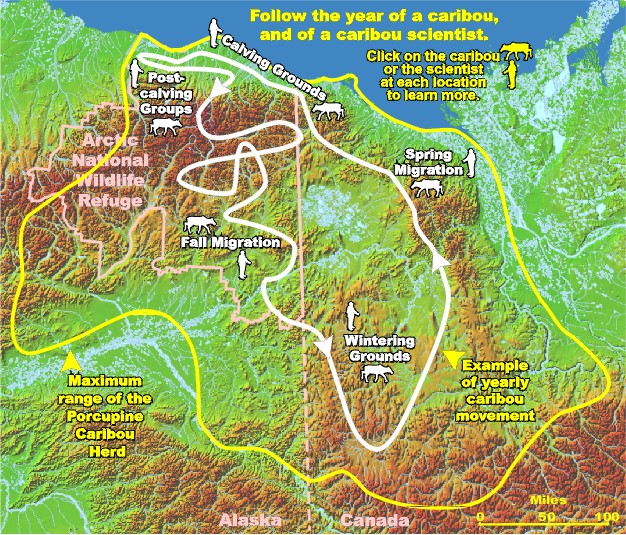
Relevant Summary of Article's Information:
The Pocupine Caribou Herd is made up of an estimated 129,000 members. The herd spends winters in the southern portion of the refuge (and outside of refuge). The herb migrates twice a year more than 700 miles to ANWR's Coastal Plane. The pregnant cows normally reach the calving areas in the Coastal Plane by early June and give birth. Soon afterwards, the rest of the herd joins the cows in their calving ground. About a month afterwards, when hords of mosquitos hatch, the caribou will migrate north seeking releif from the insects. They will travel along the coast, and to the uplands in Brook's Range.
Calving grounds: the northern foot hills of the Brooks Range and the arctic Coastal Plane from from the Tamarayiak River in Alaska to the Babbage river in Canada. Most often used calving grounds are on the Coastal Plane between the Katakturuk and Kongaut rivers where normally, 50% - 75% of the herds' calves are born.
ANWR's Coastal Plane: Two main reasons why it is vital to calving success for the porcupine caribou herd:
1) fewer brown bears, wolves, and golden eagles live on the coastal plane so newborns have greater chance of survival in the first week until stong enough to outrun their predators.
2) Coastal plane provides proper nutrition needed for calving . There is an abundance of plane species and after a lont winter, th pregnant cows need to have good nutrition
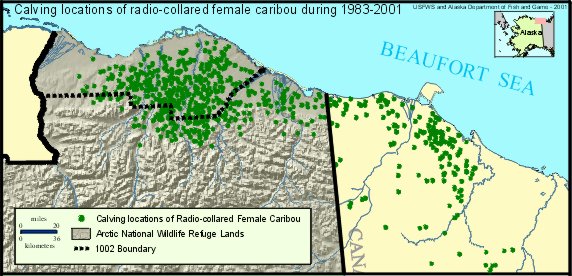
Relevancy of this arcticle to Mission 2007:
The porcupine caribou herd face many hardships every year including being hunted, harassed by large swarms of mosquitos, very harsh weather conditions, challanged by river crossings... Despite all these hardships, they succeed in returning to their breeding site on the Coastal plane every year. They are a vital part of ANWR's ecosysytem and therefor must be taken into great consideration when planning the most environmantaly effecient way to extract oil . The porcupine' caribou herd's relation to the Coastal Plane is part of an unaltered system which brings new life to the Caribou after a long and harsh winter.
--------------------------------------------------------------------------------------------------------------------------
Title: A Caribou Year
Bias: compared to most sources, very factual information is presented.
Source: U.S. Fish and wildlife
Relevancy of Information to Mission 2007:
It is vital to research in detail the migratory parhs of the Porcupine Caribou Herd before formulating a plan to extract oil. Precautions should be made with utmost carefulness inorder to mitigate as much as possible the effects on the herd's migratory paths which have gone undisturbed for centuries. Without this information, a most environmantaly effecient way to extract oil from ANWR can not be formulated.
Summary of relevant information:
Fall Migration: August to October: insects are less abundant, the caribou still travel in search of nutrition but do not have the need to congregate in areas where swarms of insects can be avoided. Therefor, the caribou disperse widely and cover a large area but along parallel paths. By October, the Porcupine caribou herd has moved to the boreal forest.
Spring Migration: In late March, the caribou have an instinct telling them that spring is near inspite of the harsh weather that still prevails that time of year. Females and their calves from previous year begin to head north before the rest of the heard in order to reach the Coastal Plane breeding area in time. Spring miration is in its fulllest in late April
---------------------------------------------------------------------------------------------------------------------------
Title: Where do the moose go? Solving a Moose Migration Mystery
for full text: http://www.r7.fws.gov/nwr/arctic/moosesdy.html
Source: U.S. Fish and Wildlife Service
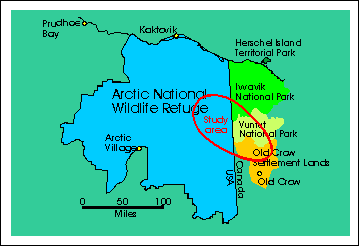
Summary of Relevant Information: Moose come into the mountain valleys in the eastern portion of the Arctic Refuge every fall and leave every spring. The moose begin to migrate from the Kongakut River Area south to the Old Crow Flats where they normally arrive by late May. At this time, most of the calves are born. They remain in the Old Crow Flats all summer. According to data collected, movement to Alaske is completed by early winter.
Relevency of Information to Mission 2007: Since mooses' calving grounds arfe in Canada (Old Crow Flats) and their migratory paths do not include a main route through the 1002 region, one can safely predict that the impact on the moose should be much less a factor than the impact oil extraction would have on species whoose primary breeding and/or calving grounds are in the 1002 region. However it is important to be aware of their migratory paths thus I have presented this information.
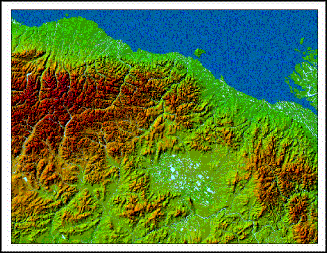
Source: National Fish and Wildlife Survey
Title: Polar bears
Polar Bears
Summary:
Although Polar Bear breeding occurs on ice, once pregnant, the females migrate to the Coastal Plane in order to make dens, give birth to and nurse their young. The Coastal Plane is America’s only polar bear denning site and one of the world’s largest polar bear denning sites. In research conducted on the Beaufort Sea Region, it was discovered that in the months of May through August the bears shifted locations to the north and remained there till October
Important Considerations: Although hydrocarbons have serious ramifications on all wildlife, polar bears reproduction rates and rapid growth will not be severely altered if oil is to be extracted (Amstrup et al. 1989) as can be seen in prior cases. The available data suggests that polar bears are pretty resilient to environmental disturbances (Amstrup 1993).

----------------------------------------------------------------------------------------------------------------------------
Porcupine Caribou Herd:
For more information: http://web.mit.edu/12.000/www/m2007/teams/adinafb/
The Porcupine Caribou Herd migrates to the Coastal Plane in the 1002 region every spring in order to breed. After arrival, the caribou remain on the Coastal Plane for several months because it gives the proper habitat necessary for calving. There are fewer predators on the Coastal Plane thus cows are better able to preserve body fat and milk and calves are able to mature in a more safe environment. If oil exploration is allowed in this region, an estimated 40% of the herd could be put in danger (according to U.S. Fish and Wildlife Service) and even a 5% reduction of calf survival would be enough to cause a decline in the porcupine caribou herd (USGS). The annual migration of the porcupine Caribou herd is extremely important to the Antibaskan Indians or Gwitch’in who build their houses along the migratory paths of the Caribou.
Important Considerations: In attempting to extract oil, the effects of building roads must be further explored for there is a good chance that the porcupine caribou herd’s migratory paths will change which will have a large impact on the Gwich’in whom for the past 20,000 years have centralized their lifestyle according to the porcupine caribou’s migratory paths. Further exploration should be done concerning effects on vegetation after the oil drilling.
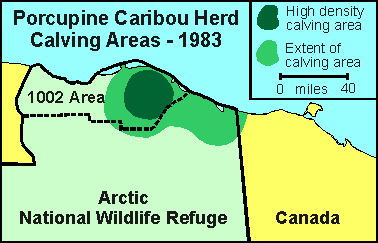
====================================================================================
Central Arctic Caribou Herd
Source: Adamczewski, J. Z., C. C. Gates, R. J. Hudson, and M. A. Price. 1987. Seasonal changes in body composition of mature female caribou and calves (Rangifer tarandus groenlandicus) on an arctic island with limited winter resources. Canadian Journal of Zoology 65:1149-1157.
Bias: While reading this extensive article, I was able to pinpoint certain biases which tried to embellish to a certain extent the effects that oil extraction woulld have on the Central Caribou Herd. I have attempted to present a summary of the relevant information.
Summary: Evidence from oil extraction in Prudhoe bay has proven its drastic effects on the caribou's habitat. From the 1970s to 1980's the Central Arctic Caribou made use of the areas of the coastal plane near drilling sites. During the calving period, caribou showed increasing avoidance of areas near drilling sites and changed their migratory routes accordingly. Within the main industrial complex, the number of caribou sevelry decreased by an estimated 78% in Caribou use and 90% in migratory paths. These were only some of the effects Prudhoe Bay drilling had over the past few decades
Success in reproduction is mainly related to the females' nutrition and calf pruduction is highly positively correlated to fat content of sexually mature females during the autumn . As researched near the Sagavanirktok River near the petroliun extraction zone, due to the roads built the herd was not able to reach their usual habitats and food supply thus leading to a reduction of femaly body fat and calf productionl. Te reduced nutrition of the females near the oil production areas the amount of two pregnancies one year after another was less than ithose living in natural habitats.
Relevancy to Mission 2007: Like all the species in the 1002 region, calving and natural habitat will change. The exact effects are unknown and it is therefor imperative that we research the effects that drilling has had in other areas in order to estimate the damage that may be caused. The Central Arctic Caribou's migratory paths and calving productivity will most likely decline as was the case near the prudhoe bay drilling sites. Wi th the loss of their preferred habitat, sexually mature females will have less body fat and thus have lower reproduction rates. Exatly how much impact there will be depends on the methods of oil extraction and the amount of roads built and the location of those roads.
Table 4.1. Parturition status of 43 radio-collared female cariboua, Central Arctic herd, west and east of the Sagavanirktok Riverb, Alaska, 1988–1994. West includes the Prudhoe Bay and Kuparuk oil fields; east was generally free of disturbance during that time. (data from Cameron 1995)




| Last updated: Nov. 4, 2003 (11:11 pm) | Team6 - m2007-6@mit.edu |